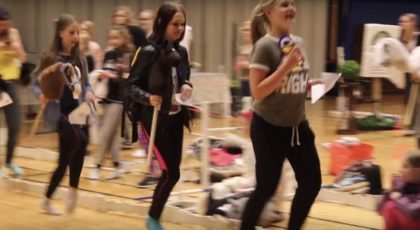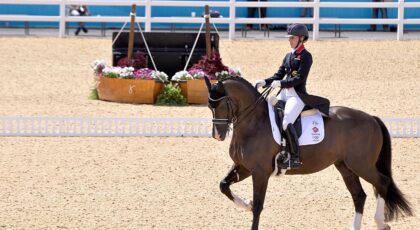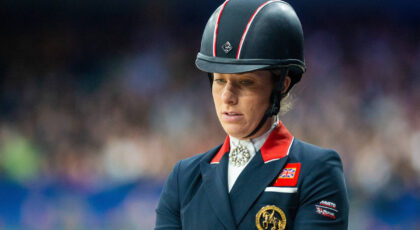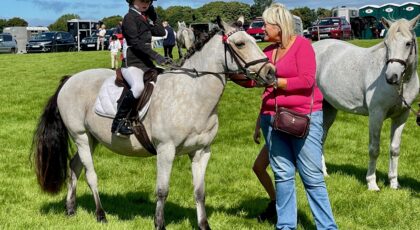One of the most important things that I have learned as a trainer and competitor is that success in the sport really comes down to strong flatwork.
As competitors, not just riders, we need to be able to dissect our errors and improve on them week after week. Improving our performance and preparing for that next class, at its core, means getting down to the basics of flatwork. After all, what we do on the flat has a direct correlation to what we ask our horses to do at any level when they walk into the show ring.
Why flat work?
“Rideability” is a training term we often use to describe creating and maintaining quality of movement in our horses. This concept, which includes self-carriage, is ultimately what we need to be effective while jumping. A horse with both rideability and self-carriage is better suited to answer the questions a course designer asks in the ring and in-between the jumps. This last part is something, I believe, that many riders overlook.
Think of it this way: Every inch of ground covered in the arena—not just what happens when the horse gets to a jump—has to be executed by horse and rider as part of a bigger plan. When you pair together the right mechanics of self-carriage with a good take off spot, it is far easier for your horse to keep the poles in the cups.
Just like golf, striking the ball perfectly is only part of hitting a good shot. Even when you make good contact with the ball, the chance of hitting your target greatly decreases without equally good mechanics in your swing. The mechanics of flatwork are just as important in equestrian sport. Poor mechanics, or a lack of rideability—your horse falling to one side or bracing against a half-halt, for example—can disrupt a perfectly good distance.
But what’s cool is that the opposite holds true as well. Even if you don’t find the perfect distance at one jump, a strong basis in good mechanics—self-carriage, balance, and impulsion in your horse—will give you the best chance of success at making it work. By focusing on rideability and flatwork, we give our horses a better opportunity to maximize their potential, no matter the take-off spot.
Make like a boat (Really)
Creating the right mechanics starts with understanding proper balance. Horses are like boats; the engine should always be in the back, creating the power. When traveling at a slower speed on the water, the front of a boat raises up, and the weight is transferred to the rear. When a boat goes faster, the front of the boat comes down and it starts to ‘plane out.’ But just because the front of the boat goes down doesn’t mean the weight of it tips forward.
Now think about the same principles on your horse. When collecting, a horse’s balance should always be upright. When galloping, the horse can plane out, but the weight and balance should remain predominantly in the back, always pushing forward from the hind-end. When a horse loses this backward impulsion, and gets “in their shoulders,” it becomes more difficult for them to corner, to slow down and speed up, and, most importantly, to leave the ground at a fence.
So how do we achieve proper balance in our horse? Let’s backtrack—flatwork, of course! You can work on balance at the walk, trot, canter, in your transitions, and over fences. Here are three different exercise to try:
Exercise 1: The Straight Line
On a straight-line, work on your lateral movements by doing a half-pass from right to left, and left to right. Before you do your half-pass, you can introduce this movement by starting with a haunches-in in both directions.
Work on the ability to move your horse’s shoulders and rib cage from side to side through your lateral movements, making sure the hind end stays connected in the process. It should never feel like you are falling one direction to another; you should be tactfully moving to the right and then the left.
Exercise 2: The Circle
On a circle, medium or small to start, practice cornering and tracking with all the body parts of the horse following one another, creating your circle. Once you’re comfortable, ensure that your horse is not “in their shoulders” by taking the exercise a step further.
Exaggerate the inside bend and move your horse’s body outward in a spiraling-out motion. Do this by using your inside indirect rein, inside leg, and inside seat bone to push their body outward. To move the horse’s shoulders, their weight must be in their hind end.
A note of caution: As you do this exercise, make sure your outside leg stays connected in the process, keeping the hind end of the horse working toward the center of your circle. After your horse accepts the motion, and carries itself on its own, you can do the same thing the opposite way—moving off your outside aids with an outside bend, essentially spiraling your horse’s track toward the center.
Exercise 3: Add Pace & Poles
The more your horse accepts this exercise, the less you will use your indirect rein and that exaggerated inside bend; the goal is to use just your seat and legs. This will create movement in the shoulders and maintain balance and self-carriage in your horse, instead of your horse leaning forward into the bridle.
Throughout these exercises, whether on a circle or a straight line, be sure that your legs are inviting the horse to move forward into any contact you have on their mouth. As you get more comfortable, you can add in changes of pace, from collection to extension, to simulate what happens in the show ring.
Start at the walk and then eventually work up to completing these movements at the trot and canter, and even over poles. Allow the poles to be ‘in your path,’ less of a distraction, more something to just ‘go over’ in the process. Our horses can’t focus only on what is in front of them, they also need to be attune to what you are asking them to do while arriving at an obstacle, all the while staying balanced.
Keep in mind…
The final goal is to achieve self-carriage throughout a course over fences. This may take time, but as your horse learns to accept these flat exercises, achieving the desired rideabilty will become easier.
As your hands become lighter, your leg can maintain the balance. When you can collect and extend, corner, and move from side to side with the correct balance, just by using your seat and leg, you and your horse will be one step closer to achieving an optimal jump.
Believe it or not, exercises like these, even at the walk, can eventually help to create more success for you and your horse in the show ring.




 April 17, 2023
April 17, 2023 




























